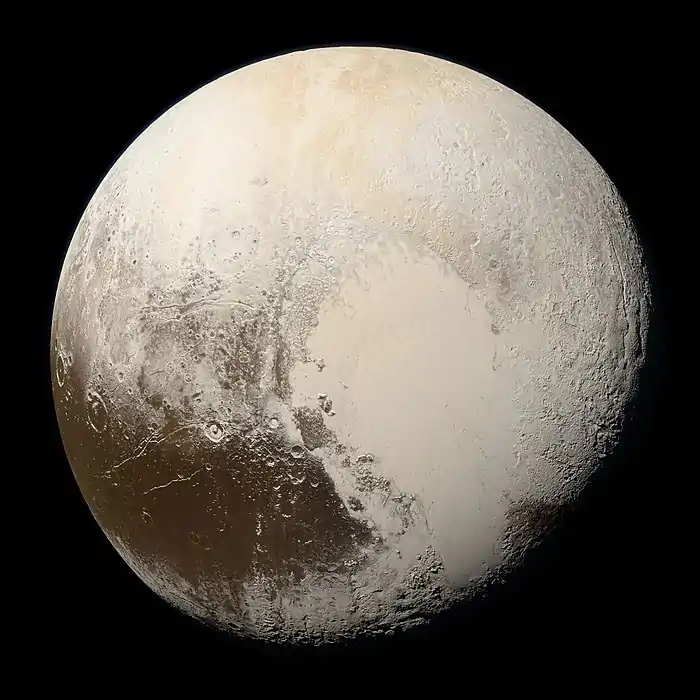2010 FX86
2010 FX86, also written 2010 FX86, is a relatively bright trans-Neptunian object[2] with an absolute magnitude of about 4.65.[2][3][6]
| Discovery[1] | |
|---|---|
| Discovered by | Observers S. S. Sheppard, A. Udalski, I. Soszynski |
| Discovery site | Las Campanas Observatory, Chile |
| Discovery date | 17 March 2010 |
| Designations | |
| 2010 FX86 | |
| TNO[2] distant[3] | |
| Orbital characteristics[2] | |
| Epoch 27 April 2019 (JD 2458600.5) | |
| Uncertainty parameter 3 | |
| Observation arc | 2634 days (7.21 yr) |
| Aphelion | 50.161 AU (7.5040 Tm) |
| Perihelion | 44.109 AU (6.5986 Tm) |
| 47.135 AU (7.0513 Tm) | |
| Eccentricity | 0.064199 |
| 323.61 yr (118199 d) | |
| 295.094° | |
| 0° 0m 10.965s /day | |
| Inclination | 25.1697° |
| 311.074° | |
| ≈ 25 February 2084[4] ±44 days | |
| 347.887° | |
| Earth MOID | 43.0966 AU (6.44716 Tm) |
| Jupiter MOID | 39.0007 AU (5.83442 Tm) |
| Physical characteristics | |
Mean diameter | 305–682 km[2][3][5][lower-alpha 1] 549 km[6][lower-alpha 2] |
| 15.80 h (0.658 d)[2][lower-alpha 3] | |
| 0.09 (assumed)[6] | |
| 4.7[2][3] 4.6[6] | |
It was first discovered on 17 March 2010, at Las Campanas Observatory in Chile, by S. S. Sheppard, A. Udalski and I. Soszynski. No earlier precovery images for it have been found. It is estimated to be about 520 kilometres (320 mi) in diameter,[6] with a rotation period of approximately 15.80 hours,[2] but as yet no detailed photometry has been taken to properly determine colour or albedo, or to better confirm its rotational lightcurve.
Astronomer Mike Brown lists 2010 FX86 as a "likely" dwarf planet, the third of five levels in his rating system.[6]
Notes
- Using 4.6 mag, Bruton formula, and typical estimated albedo for minor planets of 0.25 to 0.05; mean is 493.5 km
- estimated
- "Result based on less than full coverage, so that the period may be wrong by 30 percent or so."
References
- "MPEC 2010-G57 : 2010 FX86". Minorplanetcenter.org. Retrieved 13 June 2014.
- Alan Chamberlin. "JPL Small-Body Database Browser". Ssd.jpl.nasa.gov. Retrieved 19 August 2019.
- "IAU Minor Planet Center". Minorplanetcenter.net. 23 March 2018. Retrieved 19 August 2019.
- JPL Horizons Observer Location: @sun (Perihelion occurs when deldot changes from negative to positive. Uncertainty in time of perihelion is 3-sigma.)
- Dan Bruton. "Conversion of Absolute Magnitude to Diameter for Minor Planets". Stephen F. Austin State University, College of Sciences and Mathematics, Department of Physics, Engineering and Astronomy. Archived from the original on 23 July 2011. Retrieved 15 August 2019.
- Michael E. Brown. "How many dwarf planets are there in the outer solar system? (updates daily)". California Institute of Technology. Archived from the original on 31 May 2019. Retrieved 19 August 2019.
This article is issued from Wikipedia. The text is licensed under Creative Commons - Attribution - Sharealike. Additional terms may apply for the media files.
_(cropped).jpg.webp)

